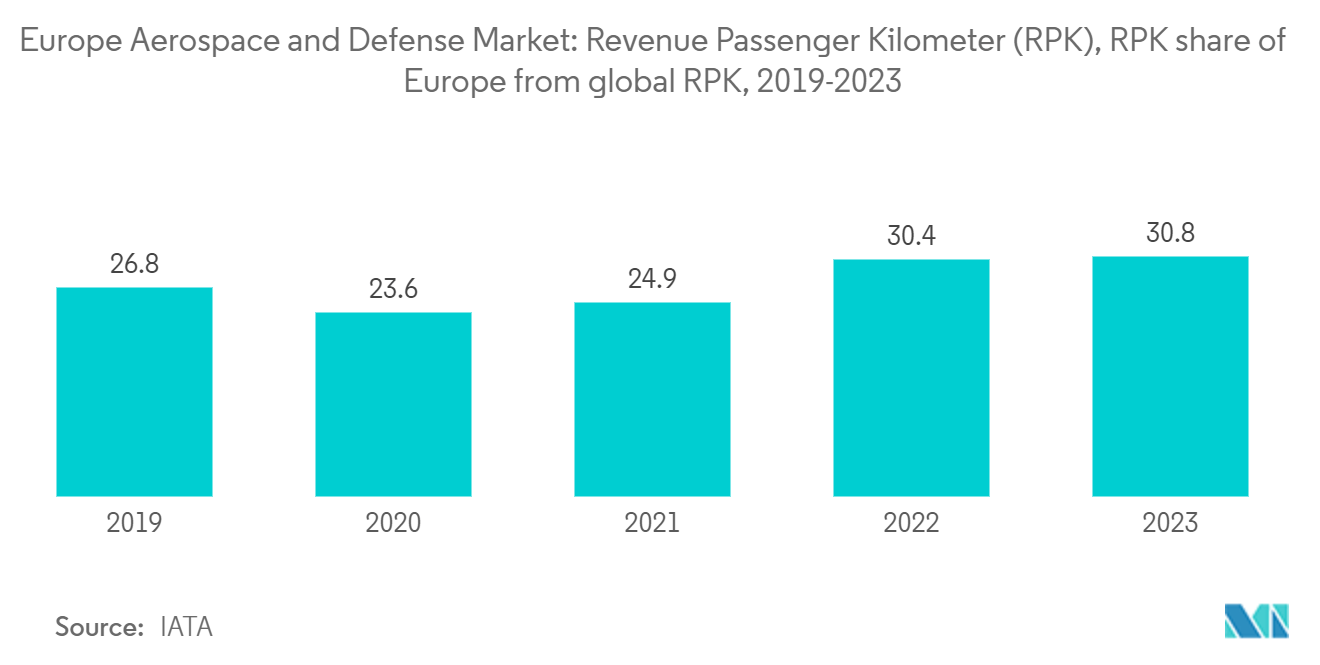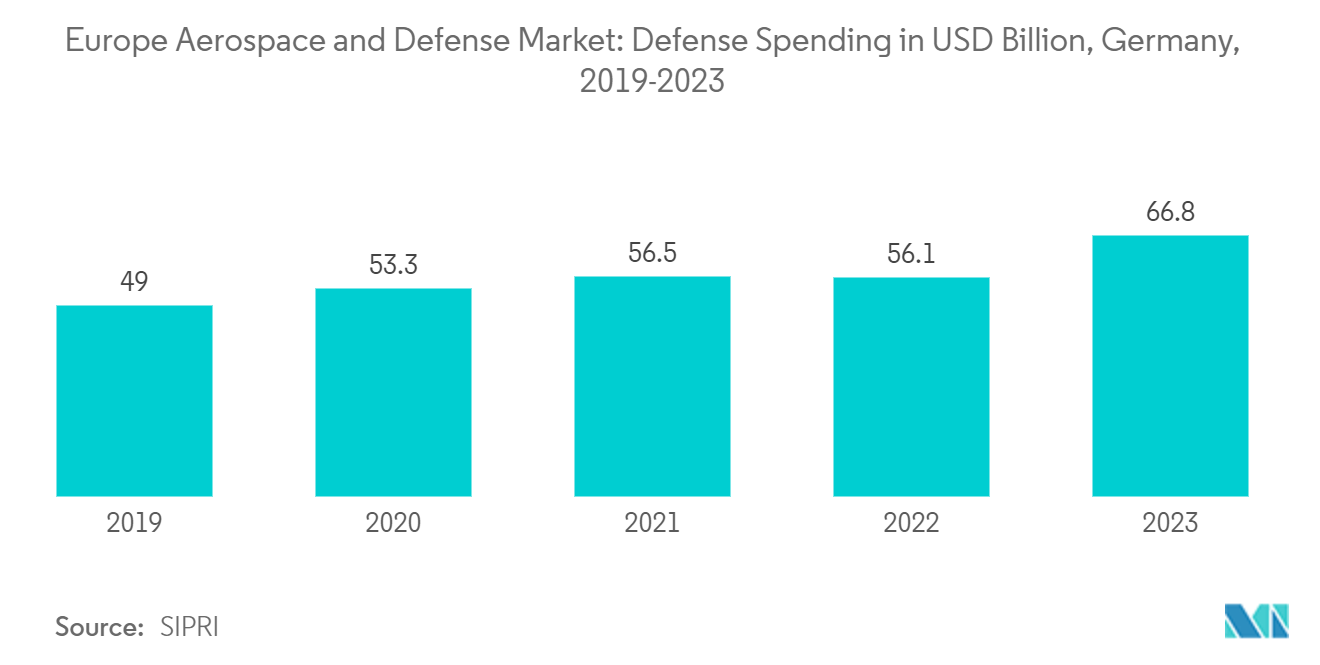Market Trends of Europe Aerospace And Defense Industry
The Commercial and General Aviation Aircraft Segment is Expected to Witness the Highest Market Growth During the Forecast Period
There has been a tremendous increase in air passenger traffic across Europe after the COVID-19 pandemic, and most countries have reached and exceeded their pre-pandemic air passenger numbers. In the first nine months of 2023, passenger traffic across the European Union was around 749 million, a 21% growth compared to 2022. International extra-EU transport accounted for 48.5% of all passengers across the European Union in the same period, while international intra-EU and national transport shares were around 36.2% and 15.3%, respectively.
Subsequently, airlines across European countries are ordering new commercial aircraft, and some are upgrading their existing fleet to serve the increasing number of passengers. Across the region, the number of commercial aircraft deliveries in 2023 was around 324, a 17% increase compared to the deliveries in 2022. Some ongoing and future commercial aircraft orders include the plans of International Airlines Group (IAG), announced in October 2023, to order 20 widebody jets to replace some of the B777s operated by British Airways in the United Kingdom. Additionally, in December 2023, Lufthansa ordered 80 new highly efficient short—and medium-haul aircraft, including 40 B737-8 MAX and 40 A220-300s, with an option of 120 aircraft. These will be delivered from 2026 to 2032.
The recovery of business aviation in 2023 was more sustained compared to 2020 and 2021. The surge in HNWI individuals is expected to aid the business jet segment in the regional market, and around 1,120 aircraft are expected to be delivered between 2024 and 2030. In 2023, the number of UHNWIs in Europe increased by 1.8% compared to 2022. This was because the Eurozone utilities, tech stocks, and luxury goods industries performed well, registering solid gains. In terms of deliveries, during 2017-2023, the large jet segment dominated the European market with a 52% share, followed by light and mid-size jets accounting for shares of 35% and 13%, respectively.
As part of this, several helicopters have been introduced into service in different geographical places. With the increasing transition toward cleaner energy, wind energy has become a viable alternative to the energy crisis, owing to which several countries have been investing in developing offshore wind farms to harvest electricity from winds. This increasing demand for helicopter services across European countries prompts the requirement for civil helicopters. Some of the procurements include Airbus Helicopters, which, in March 2022, announced the ramp-up of H160 production, with Russian helicopter service companies expected to top the demand list. However, the Russia-Ukraine war has led to significant economic sanctions on Russia from the rest of the world, and it is expected that Russia would likely force Airbus to halt production. Such procurement and development factors are expected to drive the demand in the market during the forecast period.

Germany Expected to Witness Market Growth During the Forecast Period
In the commercial segment, the demand in the aerospace and defense market in Germany is primarily fueled by increasing air traffic, which proportionally creates demand for new aircraft deliveries. For instance, in 2023, the passengers processed across all German airports accounted for 152 million, with a growth of 19% compared to 2022, which was recorded at 127 million. The data highlights a rise in air passenger traffic. In response to this growing trend, numerous airlines are placing orders for new aircraft to accommodate the increasing air passenger traffic. For instance, in December 2023, Lufthansa awarded contracts to Airbus and Boeing for 80 new aircraft deliveries between 2026 and 2032. Under the contract, Boeing will deliver 40 B737 MAX 8s, and Airbus will deliver 40 A220-300s. The agreement also covers options for 60 B737 MAX 8, 20 A220, and 40 Airbus A320s.
In the general aviation segment, the market demand is significantly influenced by the increasing number of ultra high net worth individuals (UHNWIs). These individuals prefer and often acquire business jets for their private travel needs. As their wealth and travel requirements grow, the demand for business jets and other private aviation services continues to rise. For instance, in 2023, with a growth rate of 1.1%, the UHNWI population reached 29,021 individuals, surpassing the previous year's count of 28,711.
Moreover, during 2019-2023, 82 business jets were delivered. The dominance of Airbus in the German market for helicopters used in air ambulance services, search and rescue missions, and government purposes has solidified its position as the leading provider in the industry. As of December 2023, Airbus commanded an impressive 61% market share, showcasing its ability to meet the diverse needs of these critical industries. Followed by Airbus, Eurocopter held the second-largest market share, amounting to 37%. During the same period, the country's helicopter fleet consisted of 255 helicopters, of which 121 were deployed for air ambulance services, 109 were used by the government, 22 were designated for search and rescue operations, and one for fire service.
In the military segment, the expansion of this market is being propelled by the rising defense expenditures aimed at enhancing Germany's military capabilities and adapting to emerging geopolitical threats such as terrorism. The country was the third-largest defense spender in the region and the seventh-largest globally, with a defense budget of USD 66.8 billion in 2023. Due to the Russia-Ukraine war, the German government announced plans to allocate USD 107 billion as part of a special fund for its military forces and raise its defense spending to over 2% of its gross domestic product (GDP).
Germany has substantially ramped up its defense capability investments, considering growing security threats. This increased allocation of resources is geared toward upgrading and fortifying the nation's administrative forces to bolster the country's security framework. For instance, in April 2024, Germany awarded Rheinmetall Defence Australia a contract to deliver 123 Boxer Heavy Weapon Carrier vehicles for the German Army for USD 2.7 billion, with deliveries starting in 2025. Similarly, in June 2024, Rheinmetall was granted a contract by Germany to supply 200,000 howitzer shells valued at USD 957 million. These newly acquired shells will replenish the German army's stockpiles as Germany supports Ukraine in countering the Russian military forces.
Germany is also drafting new laws to attract private investments in satellite manufacturing. The country is renowned globally for its technical superiority. Thus, a well-formulated legal framework may enable localized market players to enhance their operational capabilities and cater to an emerging space economy. For instance, during 2019-2023, 23 satellites were manufactured and launched by various operators across the country. The launch vehicle that launched the most satellites was Soyuz-2.1b, which carried nearly seven satellites, followed by Falcon 9, which launched five satellites. These developments are anticipated to positively drive market demand in these segments throughout the forecast period.


